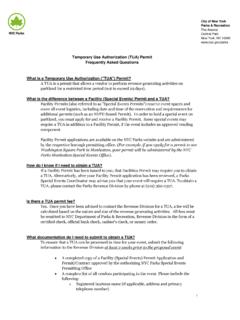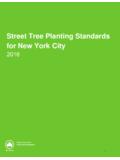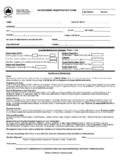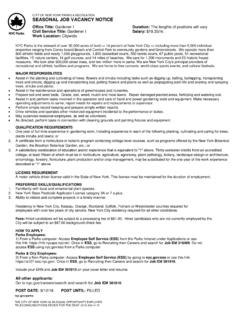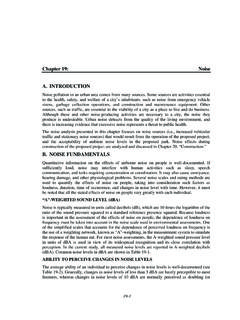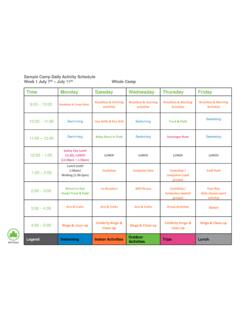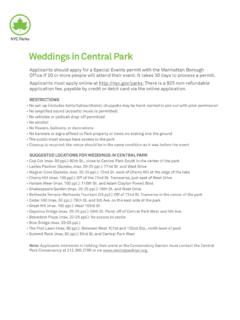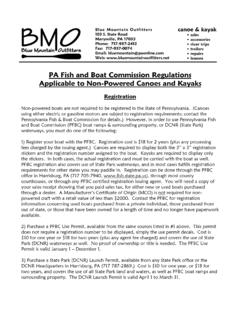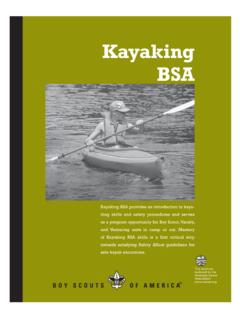Transcription of KAYAK, CANOE AND BOAT LAUNCH APPLICATION RULES …
1 City of New York Parks & Recreation KAYAK, CANOE AND BOAT LAUNCH APPLICATION . RULES AND RECOMMENDATIONS. The success of the City's boat launches both for human-powered and non-human-powered craft alike is dependent upon our safety record. To assure compliance with safety requirements, the City requires a permit for the use of all City kayak and CANOE , power and sailboat LAUNCH facilities. Permit applications may be submitted by mail or in person at the permit offices listed below. The fee for each permit is $15. Payment may be made by credit card, check, or money order (if paying by check please make payable to City of New York Dept. Parks & Rec. ). Cash is accepted at the Arsenal only.
2 Bronx Ranaqua, 1 Bronx River Parkway, Bronx Park East and Birchall Ave Bronx, NY 10462. (718) 430-1840. Brooklyn Litchfield Villa 95 Prospect Park West and 5th Street Brooklyn, NY 11215. (718) 965-8919. Manhattan: The Arsenal, 830 Fifth Avenue and Central Park New York, NY 10065. (212) 360-8133. Queens The Passerelle Building, across from the outdoor tennis courts Flushing Meadows Corona Park, Flushing, NY 11368. (718) 393-7272. Staten Island Greenbelt Recreation Center 501 Brielle Ave Staten Island, NY 10314. (718) 667-3547 ext. 312 or 313. It is important that you read the following conditions and RULES carefully. Issuance of this permit is based on your affirmation that you have read the conditions and RULES and that you understand and agree to abide by them.
3 You alone are responsible for your own safety and that of your passengers. Failure to abide by these conditions and RULES shall lead to revocation of the permit. Power and Sailboat LAUNCH Permits This permit allows power and sailboat launching only at the following facilities and only at the free public LAUNCH sites as marked by NYC Parks signage: World's Fair Marina, Flushing Bay, Queens (718) 478-0480. Bayside Marina, Little Neck Bay, Queens (718) 229-0097. Lemon Creek, Prince's Bay, Staten Island (718) 605-1301. Power and sailboat launching at other NYC Parks marinas is subject to applicable fees and permits. For a complete list of NYC Parks Marinas and boating information visit the Parks website, Kayak and CANOE LAUNCH Permits This permit allows kayak, CANOE and other human-powered vessel launching at all NYC Parks-designated LAUNCH sites.
4 The complete list of NYC Parks human-powered vessel LAUNCH sites is available on the Parks website. Please note: 1. NYC Parks Kayak and CANOE Launches, as well as Power and Sailboat Launches, may only be used from April 1st to December 1st, and only during the hours between sunrise and sunset. 2. Power and sailboats may not LAUNCH at kayak/ CANOE LAUNCH sites. 3. LAUNCH Permits are non-transferable and only valid for the individual named on the permit. Safety Recommendations for All Boating 1. You must be familiar with and obey all federal, state and local boating RULES and regulations. These include but are not limited to: a. All vessels are subject to safety inspection at any time by any federal, state, or local authorities.
5 B. All persons aboard a human-powered craft must wear Personal Flotation Devices (PFDs) at all times. It is recommended that all persons aboard power and sailboats wear PFDs at all times as well. New York State Boating Law requires that every pleasure vessel, including kayaks , canoes and rowboats, must have on board one Coast Guard approved wearable PFD for each person on the vessel. In addition, vessels 16 feet and greater in length must also carry a throwable PFD. Any youth under the age of 12 must wear a PFD. Any person on a pleasure vessel under 21 feet in length, operating between November 1st and May 1st, must wear a PFD. c. Both a sound-producing device such as a small air horn or loud whistle-and a distress flag or flare or flashlight should be carried in case of an emergency.
6 D. All vessels must obey the RULES of the Road. These include, but are not limited to: I. When two vessels are on a collision course in a crossing situation, the vessel on the right has the right of way. II. Vessels without mechanized power have the right of way, however smaller vessels must yield to larger vessels that are not as maneuverable. It is also wise to yield to fast-moving powerboats. III. A vessel being overtaken should maintain its speed and direction. IV. A vessel overtaking another should stay clear of the craft being overtaken. V. In any case, take whatever action is necessary to avoid the collision. e. Federal and state regulations prohibit mooring, that is, tying up to navigation aids such as channel markers and buoys except under emergency conditions.
7 F. Negligent or grossly negligent operation of a recreational craft that endangers lives or property is not permitted. Examples of negligent operation include: I. Operating a vessel in a swimming area. II. Operating a vessel while under the influence of drugs or alcohol. III. Permitting passengers to ride on the bow, seatbacks or gunwales. 2. Because this is a water-use program, landing on any lands or shoreline or islands, other than a LAUNCH site or designated dock, is not allowed, except in an emergency. 3. Use up-to-date navigational charts of the water, tidal current charts, tide tables, and consult the Local National Oceanographic and Atmospheric Administration (NOAA) weather station.
8 In addition, check your local newspapers for weather and general tide information. 4. It is much safer to travel with companions. 5. Always carry an additional means of propulsion, whether it is a paddle or oar when operating a human-powered craft. Sailing vessels should be equipped with an auxiliary engine. 6. Never carry more persons than recommended by the manufacturer for the capacity of your vessel. 7. When either air or water temperatures are cold, it is advisable to wear an exposure (dry) suit when operating a human-powered craft. 8. Because the shoreline can accumulate broken glass, rusted metal and other hazardous objects, passengers and operators alike should all wear foot covering when getting in and out of vessels.
9 9. Be aware that derelict cars, old boats and rotting pilings may be submerged in many of the shoreline areas. In addition, be on the alert for people fishing from bridges, unexpected approaching speedboats, and construction or repair activities. 10. Operators should be trained in first aid and know how to deal with hypothermia. 11. You should leave a detailed trip plan (or float plan ) with your family or friends. Trip plans describe the trip you are planning to take in your vessel and list anyone who is travelling with you. There is a trip plan form included in this packet, or you can download one from the United States Coast Guard. Equipment Recommendations All vessels, including kayaks and canoes, should carry the following: a) Portable VHF Marine radio b) Fully charged cell phone c) Sound producing device air horn or whistle d) Bailer e) Lines for bow and stern and extra line f) Distress flag g) Flare or flashlight h) First aid kit i) Sunglasses, sunscreen j) Drinking water k) Compass, charts, tide tables, current charts l) Duct tape for emergency repairs m) Waterproof containers for spare clothing, charts, etc.
10 RULES FOR OPERATING A KAYAK OR CANOE . The following is an excerpt, taken from the Park RULES & Regulations and shall apply to all City kayak or CANOE LAUNCH permit sites and parking areas for boaters using the aforementioned sites, under the jurisdiction of New York City Department of Parks & Recreation. 2-06 kayaks and Canoes a. A permit allows a permittee and his or her guests to use the City's access facilities for a kayak or CANOE . A permittee may have more than one boat listed on his or her permit, but each kayak or CANOE on the water must carry a permittee. b. The permittee is responsible for the safety of all those in his or her craft. Operation of the kayak or CANOE under a permit is solely at the operator's own risk.
